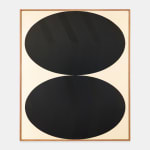Roy Kiyooka Canadian, 1926-1994
127 x 105.4 cm.
'Roy Kiyooka - 64 "Black Ovals"' inscribed on stretcher bar
Further images
Provenance
Grippi & Waddell, New YorkPrivate Collection, USA
Thence by descent to Private Collection, USA
Often regarded for his strides in conceptual photography, Japanese-Canadian artist Roy Kiyooka first emerged in the Vancouver art scene as an advocate of post-painterly abstraction. Influenced by his encounters with Barnett Newman and Clement Greenberg at the Emma Lake Workshops, Kiyooka pushed Vancouver beyond regionalism with hard-edge abstraction, first exhibiting Black Ovals at Grippi & Waddell Gallery in New York. Throughout his career, Kiyooka assumed teaching positions at the Vancouver School of Art (now Emily Carr University of Art + Design) and University of British Columbia, encouraging a new generation of artists to look towards an international context in their work. In 1971, Kiyooka was named the head of the NSCAD painting department.
Formal ideas of pictorial depth and flatness were central concerns to his early practice. Using a combination of aqua-tex acrylic paint and rhoplex emulsion, Kiyooka developed visual tension through differing matte surfaces, guiding the viewer between areas emphasizing flatness and material presence against more glossy finishes. Kiyooka suggested that the oval motif ‘evoke[d] the arches of the Granville Street Bridge’ but his repeated use of mandalas and curvilinear forms lended itself to a warmer, more organic aptitude to that of his minimalist contemporaries.
Executed during a transformative time in Kiyooka’s practice, in which he rejected the modernist aesthetic and moved towards a conceptual, multi-disciplinary approach, Black Ovals is a rare and vital example of an influential Canadian's contribution to painting.









